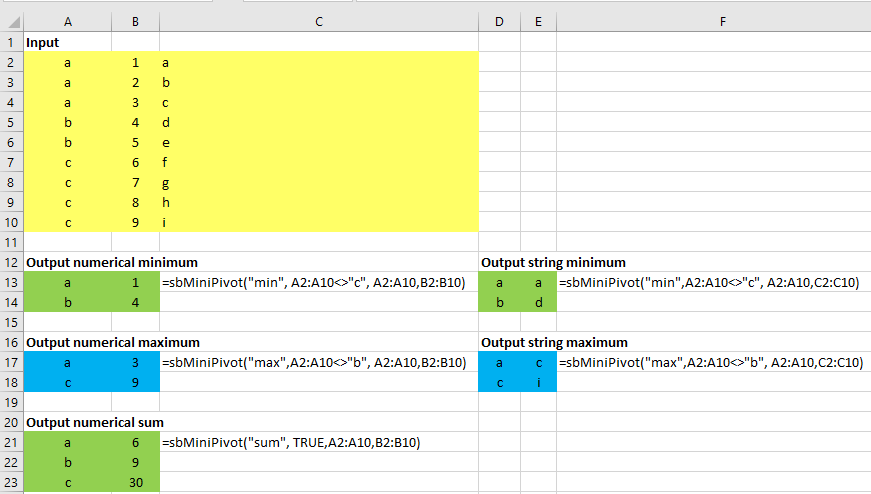“It’s not what you look at that matters, it’s what you see.” [Henry David Thoreau]
Bemerkung: Bitte beachten Sie dass Excel 365 Insider jetzt zwei ähnliche, aber mächtigere Tabellenblattfunktionen als sbMiniPivot anbietet - GROUPBY und PIVOTMIT. Sobald Ihr Excel auch über diese Funktionen verfügt, sollten Sie sbMiniPivot nur noch für VBA Trainingszwecke verwenden.
Abstract
Wenn Sie eine Funktion wie CAT, COUNT, MAX, MIN oder SUM auf eine Liste von Zahlen- oder Zeichenketten-Kombinationen anwenden wollen und dabei auch Nebenbedingungen erfüllt werden sollen, dann können Sie sbMiniPivot verwenden:

Name
sbMiniPivot - Verbinde, zähle, summiere oder gib das Minimum oder Maximum der letzten gegebenen Eingabespalte zurück für alle Kombinationen der vorherigen Spalteneinträge bei der die entsprechende Zeile der Bedingungsspalte WAHR ist.
Synopsis
sbMiniPivot(sFunction, vCondition, ParamArray vInput)
Beschreibung
sbMiniPivot führt die Funktion sFunction für die letzte Spalte von vInput aus für alle Kombinationen der vorhergehenden Spalten bei der der entsprechende Wert in der Bedingungsspalte vCondition WAHR ist. Es wird ein Variant Array zurückgegeben.
Optionen
sFunction - Spezifiziert die Funktion, die auf alle Kombinationen angewendet wird. Dies kann concatenate (cat), count, max(imum), min(imum), oder sum sein.
vCondition - Die Bedingungskonstante WAHR oder FALSCH oder eine Spalte mit Boolschen WAHR/FALSCH Werten
vInput - Zwei oder mehr Spalten. sFunction wird auf die letzte Spalte für alle Kombinationen der vorigen Spalten angewandt bei der der entsprechende Wert der Bedingungsspalte WAHR ist.
Appendix – Programmcode sbMiniPivot
Bitte den Haftungsausschluss im Impressum beachten.
Option Explicit
Enum mc_Macro_Categories
mcFinancial = 1
mcDate_and_Time
mcMath_and_Trig
mcStatistical
mcLookup_and_Reference
mcDatabase
mcText
mcLogical
mcInformation
mcCommands
mcCustomizing
mcMacro_Control
mcDDE_External
mcUser_Defined
mcFirst_custom_category
mcSecond_custom_category 'and so on
End Enum 'mc_Macro_Categories
Function sbMiniPivot(sFunction As String, _
vCondition As Variant, _
ParamArray vInput() As Variant) As Variant
'sbMiniPivot performs the function sFunction on last given column of
'vInput() for all combinations of the previous ones where corresponding
'elements of vCondition are TRUE.
'Example:
' A B C
' 1 Smith Adam 1
' 2 Myer Ben 3
' 3 Smith Ben 2
' 4 Smith Adam 7
' 5 Myer Ben 4
'Now array-enter into D1
'=sbMiniPivot("sum", B1:B5="Ben", A1:A5,B1:B5,C1:C5) and you will get
' D E F
' 1 Myer Ben 7
' 2 Smith Ben 2
'Source (EN): http://www.sulprobil.de/sbminipivot_en/
'Source (DE): http://www.berndplumhoff.de/sbminipivot_de/
'(C) (P) by Bernd Plumhoff 31-Jul-2022 PB V1.1
Dim b As Boolean, bCondition As Boolean
Dim i As Long, j As Long, k As Long, liscount As Long
Dim lvdim As Long, lcdim As Long
Dim obj As Object
Dim s As String, sC As String
Dim vR As Variant
With Application.WorksheetFunction
sC = "|"
k = 0
vInput(0) = .Transpose(.Transpose(vInput(0)))
If LCase(sFunction) = "count" Then liscount = 1
If UBound(vInput) < 1 - liscount Then
sbMiniPivot = CVErr(xlErrValue)
Exit Function
End If
lvdim = UBound(vInput(0))
Select Case VarType(vCondition)
Case vbBoolean
bCondition = True
Case vbArray + vbVariant
bCondition = False
vCondition = .Transpose(.Transpose(vCondition))
lcdim = UBound(vCondition, 1)
If lcdim <> lvdim Then
sbMiniPivot = CVErr(xlErrRef)
Exit Function
End If
Case Else
sbMiniPivot = CVErr(xlErrNA)
Exit Function
End Select
If lvdim > 100 Then lvdim = 100 'Let us start with small dimension
On Error GoTo ErrHdl
ReDim vR(0 To UBound(vInput) + liscount, 1 To lvdim)
For j = 1 To UBound(vInput)
vInput(j) = .Transpose(.Transpose(vInput(j)))
If UBound(vInput(0)) <> UBound(vInput(j)) Then
sbMiniPivot = CVErr(xlErrRef)
Exit Function
End If
Next j
Set obj = CreateObject("Scripting.Dictionary")
For i = 1 To UBound(vInput(0))
b = bCondition
If Not b Then b = vCondition(i, 1)
If b Then
s = vInput(0)(i, 1)
For j = 1 To UBound(vInput) - 1 + liscount
s = s & sC & vInput(j)(i, 1)
Next j
If obj.Item(s) > 0 Then
Select Case LCase(sFunction)
Case "cat", "concatenate"
vR(UBound(vInput), obj.Item(s)) = vR(UBound(vInput), _
obj.Item(s)) & "," & vInput(UBound(vInput))(i, 1)
Case "count"
vR(UBound(vInput) + 1, obj.Item(s)) = vR(UBound(vInput) + 1, _
obj.Item(s)) + 1
Case "max", "maximum"
If vR(UBound(vInput), obj.Item(s)) < vInput(UBound(vInput))(i, 1) Then
vR(UBound(vInput), obj.Item(s)) = vInput(UBound(vInput))(i, 1)
End If
Case "min", "minimum"
If vR(UBound(vInput), obj.Item(s)) > vInput(UBound(vInput))(i, 1) Then
vR(UBound(vInput), obj.Item(s)) = vInput(UBound(vInput))(i, 1)
End If
Case "sum"
vR(UBound(vInput), obj.Item(s)) = vR(UBound(vInput), _
obj.Item(s)) + vInput(UBound(vInput))(i, 1)
Case Else
sbMiniPivot = CVErr(xlErrRef)
End Select
Else
k = k + 1
obj.Item(s) = k
For j = 0 To UBound(vInput)
vR(j, k) = vInput(j)(i, 1)
Next j
If liscount = 1 Then vR(UBound(vInput) + 1, k) = 1
End If
End If
Next i
'Reduce result array to used area
If k > 0 Then ReDim Preserve vR(0 To UBound(vInput) + liscount, 1 To k)
sbMiniPivot = .Transpose(vR)
Set obj = Nothing
End With
Exit Function
ErrHdl:
If Err.Number = 9 Then
If i > lvdim Then
'Here we normally get if we breach Ubound(vR,2)
'So we need to increase last dimension
lvdim = 10 * lvdim
If lvdim > UBound(vInput(0)) Then lvdim = UBound(vInput(0))
ReDim Preserve vR(0 To UBound(vInput) + liscount, 1 To lvdim)
Resume 'Back to statement which caused error
End If
End If
'Other error - terminate
On Error GoTo 0
Resume
End Function
Sub DescribeFunction_sbMiniPivot()
'Run this only once, then you will see this description in the function menu
Dim FuncName As String, FuncDesc As String, Category As String
Dim ArgDesc(1 To 3) As String
FuncName = "sbMiniPivot"
FuncDesc = "Concatenate, count, sum or return min or max of last given input " & _
"column for all combinations of the previous ones where same row " & _
"of condition column is True"
Category = mcStatistical
ArgDesc(1) = "Function to apply - cat, count, max, min, or sum"
ArgDesc(2) = "Condition constant True or False or column which contains True/False values"
ArgDesc(3) = "Two or more columns"
Application.MacroOptions _
Macro:=FuncName, _
Description:=FuncDesc, _
Category:=Category, _
ArgumentDescriptions:=ArgDesc
End Sub
Download
Bitte den Haftungsausschluss im Impressum beachten.
sbMiniPivot.xlsm [41 KB Excel Datei, ohne jegliche Gewährleistung]